In the steel industry, blast furnaces and furnaces operate under extremely harsh conditions, with rapid temperature changes being a common challenge. Andalusite refractory bricks stand out due to their unique material characteristics. For instance, they have a high load - softening temperature, typically around 1600 - 1700°C. This high temperature resistance allows them to maintain their structural integrity even under high - temperature and high - pressure conditions in the furnace.
Another key feature is their low thermal expansion coefficient. With a coefficient as low as 0.5 - 1.0% in the temperature range of 20 - 1000°C, andalusite refractory bricks can effectively resist the damage caused by thermal stress during rapid temperature changes. These characteristics make them an ideal choice for withstanding the rapid temperature variations in steel furnaces.
When selecting andalusite refractory bricks, several important criteria need to be considered. In terms of composition, the content of andalusite should be above 80% to ensure high - performance. Density is also a crucial factor, with a recommended density of 2.3 - 2.5 g/cm³. As for strength indicators, the compressive strength should be no less than 50 MPa, and the flexural strength should be around 10 - 15 MPa.
Proper installation is essential for the performance of andalusite refractory bricks. The masonry process should follow strict standards. For example, the mortar used should have good adhesion and heat resistance. When setting up expansion joints, a width of 3 - 5 mm is usually recommended to accommodate the thermal expansion of the bricks during operation.
Regular daily inspections are crucial for early detection of thermal shock damage. Visual inspection is the most basic method. Inspectors should look for obvious cracks, spalling, or deformation on the surface of the bricks. Infrared thermography can be used to detect temperature anomalies, as abnormal temperature distributions may indicate internal damage. Vibration analysis can also help identify early - stage damage by detecting changes in the vibration frequency of the furnace structure.
| Inspection Method | Function |
|---|---|
| Visual Inspection | Detect obvious surface damage |
| Infrared Thermography | Detect temperature anomalies |
| Vibration Analysis | Detect internal structural changes |

In a real - world steel plant, the andalusite refractory bricks in a blast furnace started to show minor cracks after several months of operation. Through regular inspections, the engineers detected these early - stage cracks. As time passed, without proper maintenance, the cracks gradually expanded.
For minor cracks, surface repair methods such as applying refractory coatings can be used. For more severe cracks, partial replacement of the damaged bricks may be necessary. This case clearly demonstrates the importance of preventive maintenance.
"Preventive maintenance of andalusite refractory bricks can significantly reduce the risk of furnace shutdowns and extend the service life of the furnace," said an industry expert.
Andalusite refractory bricks play a vital role in the steel industry's blast furnaces and furnaces. Their unique material characteristics, proper selection, installation, and regular maintenance are all crucial for ensuring the safe and efficient operation of the furnace. By following the methods and strategies described in this article, engineers can effectively identify and address thermal shock damage, reduce the risk of shutdowns, and improve the overall performance of the furnace.


